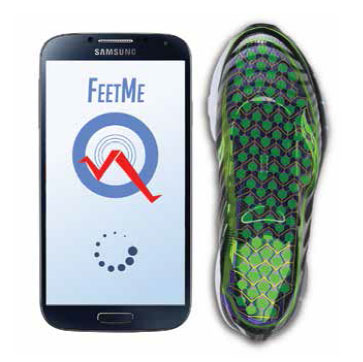FeetMe Preventing Diabetic Foot Ulcers with Ambulatory Pressure-Sensing
Health Tech | Given its increased cardiovascular risks, diabetes is a comorbidity that cardiologists often have to manage. One of the most deleterious and insidious health problems associated with diabetes is peripheral neuropathy, which can lead to painful ulcers and, if left untreated, infections that lead to amputation. We recently had the opportunity to speak with Alexis Mathieu, the CEO of an innovative company called FeetMe that has developed insoles with pressure sensors meant to detect this problem. They also have applications for patients with peripheral edema, so read on if you are interested in learning more about a tool that your patients may be using sooner than you think.
|
How did you come up with the idea for FeetMe?
Broadly speaking, I have long been interested in creating new, cost-effective medical devices that improve patient care, and recognized that doing so requires a collaborative approach that focuses on the needs of patients, physicians, and the health care industry as a whole. I saw an opportunity to do so with FeetMe.
While I was a student at Ecole Polytechnique, I spent some time with diabetic patients at a nearby hospital, La Pitie Salpetrière, Paris, France. Professor Agnes Hartemann and Dr. Georges Ha-Van opened my eyes to how painful and devastating foot ulcers and peripheral wounds can be to these patients. I could not understand how, with all of the technology available today, we could not prevent these situations.
As an engineer, I tried to envision how technology could help these patients. If we could restore their peripheral sensitivity we’d be able to help them avoid putting too much prolonged pressure on their feet, which leads to the ulcers. To this end, my colleagues and I decided to design a connected pressure-sensor that would supplement the damaged nerves of the neuropath. Combined with a machine-learning algorithm that analyzes the pressure data that we collect, this sensor would enable us to alert the patient if there was increased risk of an ulcer.
What medical problems are you trying to solve?
Plantar pressure measurements are used today in a variety of clinical situations by podiatrists: for example, for post-surgery biomechanical assessment, intra-operative assessment, orthotics design, and assessment of drop-foot surgery. In addition to clinical applications, podobarography continues to be used in laboratories to understand the mechanisms governing human gait and posture.
We realized that ambulatory measurements of the plantar pressure would bring even more value in the prevention of ulcers among patients suffering from neuropathy. Diabetes is quickly growing in prevalence, with 8% more cases developing year-to-year. Among several complications, loss of sensitivity in the extremities—or diabetic neuropathy—can be one of the most damaging. Ulcers that result from neuropathy may even lead to gangrenous infection and amputation. In fact, more than 1,000,000 diabetics are amputated each year, with 100,000 in the U.S. alone. There is currently no effective and cheap tool that measures the plantar pressure to prevent this problem.
Our solution aims to make plantar pressure assessment an affordable tool for both clinicians and patients.
How can cardiologists and their patients benefit from FeetMe?
One case is in monitoring patients with peripheral edema, as a result of, for example, congestive heart failure (CHF). These patients may also develop ulcers if they have any abnormal pressure issues. We believe FeetMe can also be used to effectively monitor these patients who are at risk for ulcers.
Since cardiovascular disease is the leading cause of morbidity and mortality in people with diabetes mellitus, we know that cardiologists often treat diabetic patients. Patients with diabetes mellitus have a two- to four-fold increase in the risk of developing cardiovascular disease than those without diabetes mellitus, and also a two- to five-fold increase in mortality attributable to cardiovascular disease when compared with age- and sex-matched non-diabetic patients. Accelerated atherogenesis, blood abnormalities (altered platelet function, inflammation, hypofibrinolysis, and hypercoagulability), and myocardial vulnerability in diabetic patients are now considered causative factors for life-threatening cardiovascular events.
It’s important for cardiologists to help their patients maintain good overall health. For their diabetic patients at risk for pressure ulcers, this includes feet health. That being said, our first targeted users are diabetic patients and podiatrists.
Can you describe how your technology works?
We have developed a disruptive capacitive pressure sensor technology that allows for a high resolution mapping of the foot. We collect data at a high frequency and transmit it via Bluetooth to a smartphone or a brother device. We apply our machine-learning algorithm to this data to evaluate walking patterns and send an alert to the patient if needed.
What is your stage of prototyping/piloting the product in a clinical setting?
We are in the middle of the CE mark process that will come in June and we have started a first clinical trial at La Pitié Salpétrière Hospital in Paris, France.
What is your background in medicine & technology?
I’m a former student at Ecole Polytechnique and UC Berkeley in Engineering (MS). My co-founder, Maximilien Fournier, COO, has an MS in Biomedical Engineering from UCLA and our other co-founder, Andrey Mostovov, CTO, PhD, trained at Ecole Polytechnique and INSEAD. We have created very strong relationships with Hospital de la Pitié Salpétrière where we spent a lot of time designing the product.
Interview conducted by Shiv Gaglani, who is an MD/MBA candidate at the Johns Hopkins School of Medicine and Harvard Business School. He writes about trends in medicine and technology and has had his work published in Medgadget, The Atlantic, and Emergency Physicians Monthly.
Keywords: CardioSource WorldNews, ACC Publications, Diabetes Mellitus, Foot Ulcer, Diabetic Foot, Peripheral Nervous System Diseases
< Back to Listings

